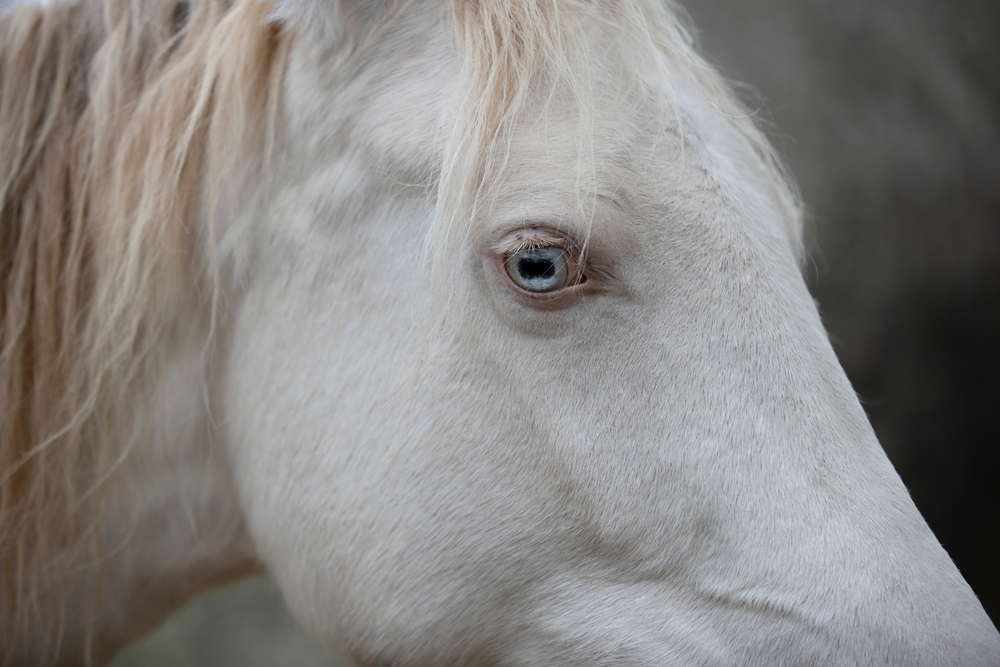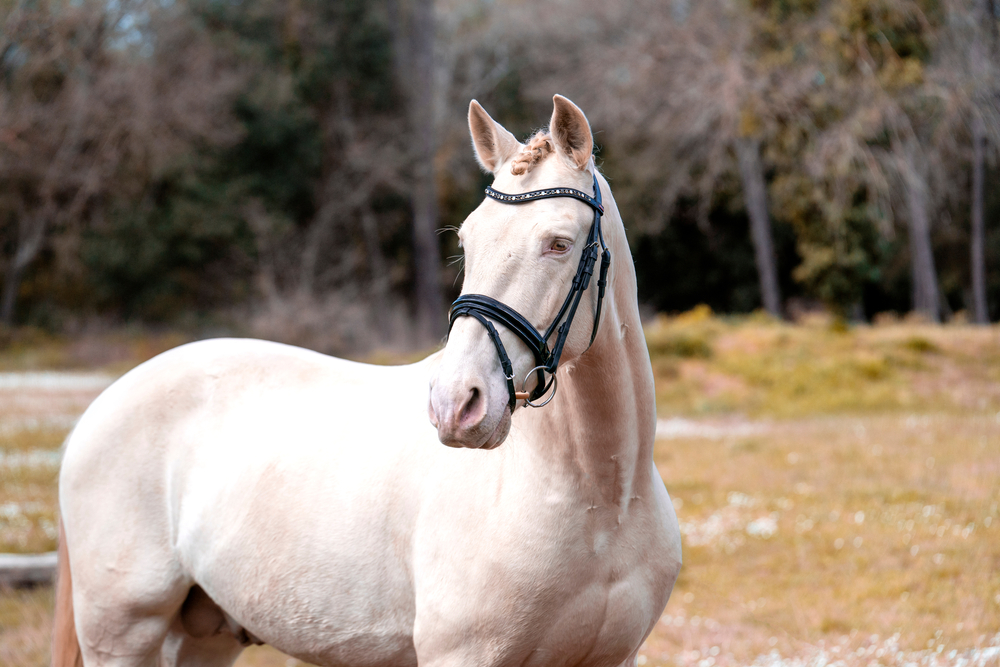- Your source for stall mats, rubber arena footing, arena harrows and arena dust control.

Albino animals and people are easily recognizable for their pink skin, pale eyes, and hair. However, despite albinism having easily identifiable traits, there remains much debate surrounding the plausibility of albino horses. Many people swear blind that albino horses exist, while others claim, that like the unicorn, albino horses belong to the realm of fantasy.
There are no true albino horses. Theoretically, a non-lethal gene mutation affecting the melanocytes’ ability to produce and distribute melanin could occur, resulting in true albinism in horses. Many non-albino horse colors, (e.g., cremello, perlino and dominant white) are mislabelled albino.
Many people claim to have bred, owned, or met albino horses. However, these assertations have given rise to strongly contested debates as people demand genetic proof to back up these seemingly “outrageous” or misinformed claims.
Do You Get Albino Horses?
Albinism is an autosomal recessive condition that causes a complete or partial loss of pigmentation in the affected person or animal’s skin, hair, and eyes. An animal or person with albinism will have pale pink-white skin, white hair, and pale red irises regardless of their race or species.
is an autosomal recessive condition that causes a complete or partial loss of pigmentation in the affected person or animal’s skin, hair, and eyes. An animal or person with albinism will have pale pink-white skin, white hair, and pale red irises regardless of their race or species.
In a non-affected person, melanocytes are responsible for producing melanin. Melanin is a chemical pigment that causes the skin, hair, and eyes to be colored.
is a chemical pigment that causes the skin, hair, and eyes to be colored.
There are different types of melanin, such as eumelanin, which is a black-brown color, and pheomelanin, which is responsible for the red-yellow shades. In albinism, although melanocytes are present, all melanin subtypes are impaired or absent.
While albinism is present in many animal species, including humans, dolphins, hedgehogs, and mice, there have been no documented accounts of albino horses .
.
Typically, people who claim to own an albino horse have mislabelled a light-colored non-albino horse.
Is An Albino Horse A Theoretical Possibility?
While there are no documented cases of true albinism in horses, this does not make the concept of an albino horse implausible. We only need to look at human history to know that the world of genetics is filled with all manner of fantastical possibilities!
It is believed that all people, regardless of race or heritage, had brown or black eyes in ancient times. Approximately 6000 to 10 000 years ago, a baby was born with a genetic mutation causing blue eyes .
.
Scientists believe that all blue-eyed individuals are descended from a single ancestor; the baby who had blue eyes grew up and had children all carrying the blue-eyed gene.
These children passed their blue-eyed gene onto their children and grandchildren until, eventually, blue eyes were common among individuals of European descent.
During sexual reproduction, two horses contribute half of their DNA to their offspring, creating a genetically unique individual. Sometimes, sexual reproduction allows genes to mutate.
Many gene mutations are lethal and cause miscarriage or early death of the foal. However, occasionally as with the blue-eyed mutation, you get a genetic mutation that radically changes one or more aspects of an entire species.
For true albinism to occur in horses, two conditions would need to be met:
- One or more genes controlling melanocytes’ production and distribution of melanin would need to mutate. The chances of a non-lethal albino mutation occurring in a horse are slim but not impossible.
- The affected horse would need to sire a line of horses carrying the albino gene. If the affected horse were sterile or failed to breed, albinism would disappear when the albino horse died.

Why Should Breeders Avoid Breeding Albino Horses?
People have always been drawn to novel or unusual things, and what could be more exotic than an albino horse?
Should an albino horse be born in the future, people will more than likely be tempted to breed a “new, exotic line” of horses; there is an undeniable attraction to owning a one-of-a-kind animal!
However, scientists warn against breeding animals for albinism as the condition is associated with numerous adverse health risks.
The four most significant consequences of albinism are:
- Cancer: Albino horses would have an increased cancer risk, especially for skin melanomas.
- Sunburn: Unlike small animals or people who can stay indoors, horses need to live outdoors, making severe sunburn a virtual certainty for albino horses.
- Light sensitivity (i.e., photophobia): The dark structures in the eyes don’t have pigment causing too much light to enter the eye; overexposure to bright light will cause the horse significant pain.
- Visual problems: Blurry vision, nystagmus, and impaired depth perception are found in people and animals with albinism. Unlike other visually impaired animals, horses become distressed when they cannot see.
What Horse Colors Are Mistaken For Albinism?
Many non-albino horse colors are mistaken for albinism; these include:
Are Cremello, Perlino And Smoky Cream Horses Albino?
Out of all the colors mistakenly labeled as albino, cremello, perlino, and smoky black are the most commonly mistaken colors.
The gene responsible for cremello, perlino, and smoky cream is known as the “cream” gene. This gene shows incomplete dominance and is due to a mutation in the SLC45A2 gene, which encodes for the membrane-associated transporter protein .
.
The incomplete dominance of the gene means that it has an accumulative or “dose-specific” effect, i.e., horses with two copies of the gene are paler than horses with one copy of the gene.
While these double dilute horses tend to have pale cream-colored coats and light blue or hazel eyes, their melanocytes are still capable of producing melanin. The ability to produce melanin precludes these homozygous cream horses from being classified as true albinos.
What Horse Color Is The Closest To Albino?
One of the rarest horse colors is Dominant White . These horses are born pure white and have unpigmented skin (in affected areas) with black, brown, hazel, or blue eyes.
. These horses are born pure white and have unpigmented skin (in affected areas) with black, brown, hazel, or blue eyes.
While these horses may look like true albinos, they differ from true albinos on a cellular level.
In a true albino, melanocytes are present but cannot produce functional quantities of melanin. In Dominant White horses, a mutation in the KIT gene causes an absence of melanocytes in the skin and hair.
There are four genes known to cause Dominant White in horses, W5, W10, W20, and W22.
Dominant White is a spotting pattern that can be limited to the legs and face or extend over the entire body. Thus, although some Dominant White horses are pure white, others will still have a dark-colored body and topline.
Conclusion
Although there have been no scientifically validated cases of true albinism in horses, many naturally occurring colors are mistaken for albinism.
Non-albino colors that affect melanin distribution cause horses to be born with a pale-colored coat and eyes, e.g., cremello, perlino, dominant white, etc.
References
- https://www.livescience.com/9578-common-ancestor-blue-eyes.html

- https://www.ncbi.nlm.nih.gov/books/NBK459156/

- https://www.sciencedirect.com/science/article/pii/B9780128139448000184

- https://www.britannica.com/science/albinism

- https://medlineplus.gov/genetics/condition/ocular-albinism/

- https://medlineplus.gov/genetics/condition/oculocutaneous-albinism/

- http://www.bio.miami.edu/dana/dox/horsecolor.html

- https://www.researchgate.net/publication/10883272_A_mutation_in_the_MATP_gene_causes_the_cream_coat_color_in_the_horse

- https://equimed.com/news/health/should-arabians-be-tested-for-lavendar-foal-syndrome

- https://vgl.ucdavis.edu/test/dominant-white-horse


